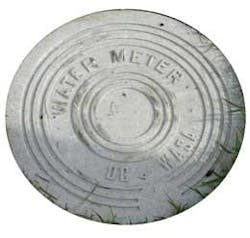Fixed Network AMR: The Right Choice for the District of Columbia
By Pamela A. Malone
With over 90,000 meters delivering daily meter readings, the District of Columbia Water and Sewer Authority (WASA) is reaping customer service and operational benefits beyond its original expectations. When fully deployed to the planned 125,000 meter points, this will represent the largest fixed network metering installation in the water industry to date.
Just over a year ago, WASA's metering system didn't exactly aide in improving the quality of life for some of its customers. In fact, it was often disruptive and a source of frustration. The reason: the metering system had reached its peak. Antiquated meters produced incorrect meter readings resulting in inaccurate bills. Meters in some locations were difficult to access, leading to estimated readings and billings. WASA also read and billed quarterly which didn't allow for timely leak detection. In some cases, leaks went undiscovered for 90 days or longer. As a result, customers complained incessantly about inaccurate or high bills. And the extended response time to handle complaints led to even more frustration.
Unsatisfactory customer service was not the only issue facing WASA. Millions of dollars were being lost due to unbilled revenues and delinquent payments. Reading costs were excessive in comparison to other water utilities in the nation. In fact, Paul Bender, Chief Financial Officer for the utility mentioned in an article published in Opflow Magazine, that "WASA's cost per read for 2002 was just under $3 U. because of the poor condition of the meters and inefficient work processesU"
As a forward-thinking, progressive utility, however, WASA didn't just sit back and wait for the situation to worsen. Authority management tackled it head-on by investing in a metering solution providing efficiency for the utility and flexibility for its customers - Hexagram's Star® Fixed-Network AMR system.
Although the system has been in operation only a short period of time, WASA is seeing improvements in customer service and other operational areas and expects the woes of the past will stay where they belong - in the past.
New Beginning
Keeping customers happy is WASA's major goal and fixed network AMR plays a crucial part in achieving that goal. With two daily meter readings, for example, the number of estimated bills is now virtually zero for those meters installed with AMR – compared to 10% of the meter population when bills were estimated. As a result, customers are paying for what they've actually used instead of overpaying or underpaying.
"The most significant change today, however, is our proactive approach to high bills before they become complaints," Bender said in a recent interview.
Now, armed with granular data from the system's database, most customer meter reading and billing issues are handled on the first call and the time it takes to investigate leaks has been substantially reduced.
"Our leak detection initiatives mirror the billing cycles which we began converting to monthly billing in March 2003. Our analysts access the Star database and compute daily consumption patterns to pinpoint when the high usage occurred. If the daily consumption indicates a leak, we dispatch an inspector to conduct a visual inspection of the meter and look for possible underground leaks. These efforts have not only sharply reduced the number of high bill complaints this year but also have improved overall turnaround time to less than 30 days," Bender said.
The move from quarterly to monthly billing has provided other benefits as well. For example, monthly billing provides customers with a better method of trending their water usage – thereby helping them manage their finances. WASA also envisions going to budget billing which will help customers anticipate bill payments and assist WASA in reducing its operational costs.
The ability to access daily information from the system via the Internet is also important in keeping customers satisfied. Now instead of having to call a customer service representative with billing questions, customers can find out information about their bill on-line – saving them time and money in the long run. If they do decide to call, with accurate and timely consumption information readily available, customer service reps can respond quickly to their issues which also allows for more efficient utilization of WASA's resources.
With AMR installation programs of this size, two questions always seem to emerge: 1) were costs actually reduced and 2) did revenue increase? In WASA's case the answer to both questions is yes.
After complete implementation of the AMR system, WASA projects revenues to increase by 5%, to $210 million and total meter reading costs to be reduced by 70%. Additionally, with timely and consistent consumption data, WASA will have a better tool to detect large meter slow-down and allow for scheduled repairs – which not only ensures revenue protection but also builds a bridge between WASA's maintenance and asset management programs.
About the Author: Pam Malone is the Director of Marketing for Hexagram, Inc. She may be contacted at (216) 464-1057 x334 or by e-mail at [email protected].


